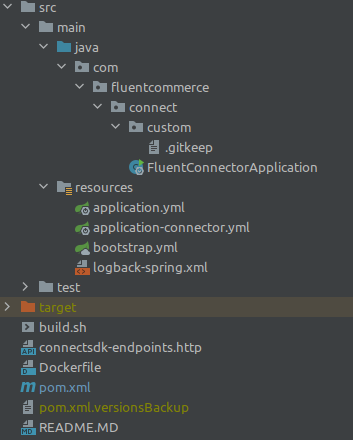SCIM Connector Package Installation
Author:
Fluent Commerce
Changed on:
9 Oct 2023
Key Points
- The SCIM connector is a Java based project that enables seamless integration with the SCIM. In order to install the SCIM Connector, you’d need to make sure you have the right dockers and tools. Next step is setting up the local environment, configuring the connector, and finally deploying the connector.
- The SCIM connector and connect SDK versions need to be aligned.
Steps
 Product Structure
Product Structure
A Fluent Connector project typically has the structure as defined below. Any customizations / extensions can be done under the custom folder or as a separate module (jar).

Regardless of which way chosen to extend it, the key message here is that any custom code should be under the
`com.fluentcommerce.connect``com.fluentcommerce.connect`1package com.fluentcommerce.connect;
2
3@EnableCaching
4@EnableScheduling
5@SpringBootApplication
6public class FluentConnectorApplication {
7 public static void main(final String[] args) {
8 SpringApplication.run(FluentConnectorApplication.class, args);
9 }
10}Language: java
Name: FluentConnectorApplication.java
Description:
[Warning: empty required content area]This project relies on three key dependencies and configurations to drive the application's behavior.
1<!-- Fluent Connect SDK -->
2 <dependency>
3 <groupId>com.fluentcommerce.connect</groupId>
4 <artifactId>connect-sdk-core</artifactId>
5 </dependency>
6 <!-- Fluent Connect SDK for AWS (allows the Connect SDK to be deployed on AWS) -->
7 <dependency>
8 <groupId>com.fluentcommerce.connect</groupId>
9 <artifactId>connect-sdk-core-aws</artifactId>
10 </dependency>
11 <!-- Fluent Connect - SCIM Connector Features-->
12 <dependency>
13 <groupId>com.fluentcommerce.connect</groupId>
14 <artifactId>scim-connector</artifactId>
15 </dependency>Language: json
Name: pom.xml
Description:
[Warning: empty required content area]All configuration files are located at
`src/main/resources` Upgrading the Connector
Upgrading the Connector
The SCIM Connector and Connect SDK version are driven by both the parent POM and dependency, as shown below. It is important that when upgrading, both versions match.
1<parent>
2 <groupId>com.fluentcommerce.connect</groupId>
3 <artifactId>connect-sdk-scim-connector</artifactId>
4 <version>1.0.0</version>
5</parent>Language: xml
Name: pom.xml
Description:
[Warning: empty required content area]Although it is possible to have a different version of the Connect SDK specified at the dependencies, letting the parent POM settings bring the correct dependency is recommended. Using a newer version may introduce problems as it hasn't been tested or released for the SCIM Connector yet.
 Development Environment Setup
Development Environment Setup
For local environment setup, follow Local Setup Guide.
Credential Configuration
Follow the Secret Setup Guide
SCIM Connector Project Configuration
Check SCIM Connector Project Configuration for more details of the application configuration files.
IDP and Fluent Configuration
Add the necessary IDP and Fluent settings to allow the connector to function properly
 Pre-Production and Production Environment Setup
Pre-Production and Production Environment Setup
The deployment steps covered here are guidelines and should not be taken to the letter as every company has different security policies, deployment, and monitoring processes. This is not a comprehensive or complete tutorial on deploying and running containers.
Building the Project
The project provides a script that builds the Java artifact and generates a docker image that can be deployed on any environment. The container expects certain variables that allow the same image to be used in different environments.
1 ./build.shLanguage: sh
Name: Build a docker image
Description:
[Warning: empty required content area]A docker image named fluent_connector_scim should be available at the build server if all goes well. At this point, the container image should be published to an image repository like AWS ECR.
Verifying it works
It is possible to run the connector on any machine with docker and docker-compose installed. The steps below show how to have the container built and running.
1# Builds the containers
2docker-compose -f docker-compose.yml build
3# Runs the containers and their logs will be visible on the terminal. To have the containers running in the background, include '-d' at the end of the command line. Note that this will not give you logs at the terminal, use docker -logs <container>.
4docker-compose -f docker-compose.yml upLanguage: sh
Name: Build & run the containers
Description:
[Warning: empty required content area]Deploying
As part of the project, it included a sample CloudFormation template that can create a stack with all that is required and deploy the container image. For more information, see Cloud Formation Template.
Please note the configuration steps required for setting up the credentials.
